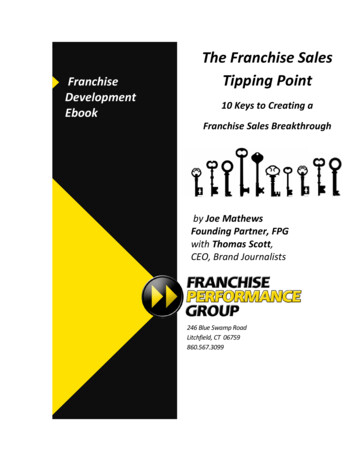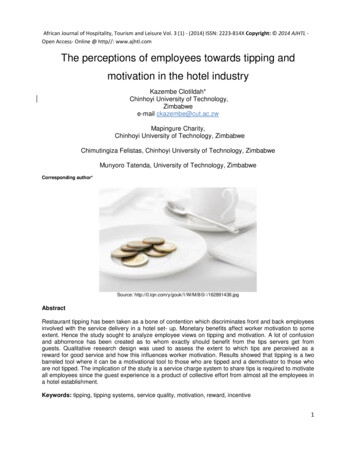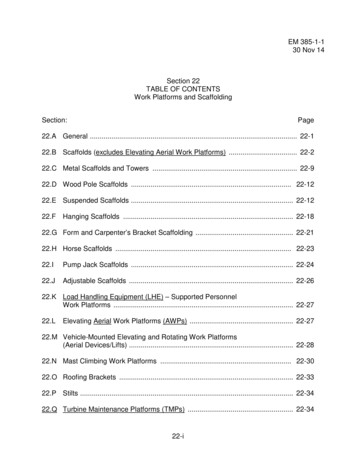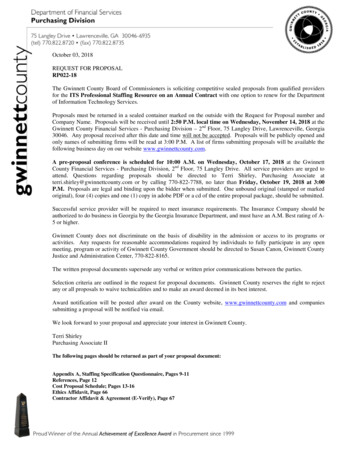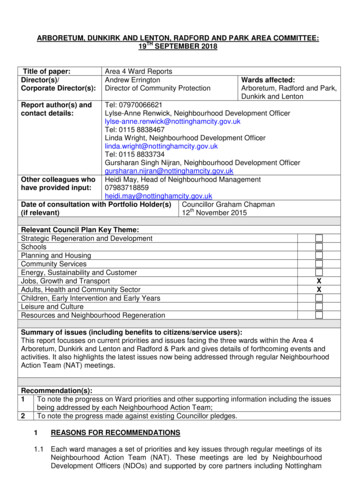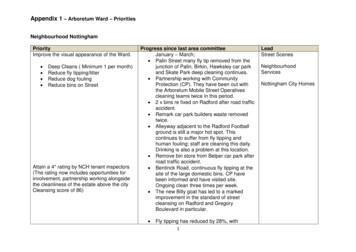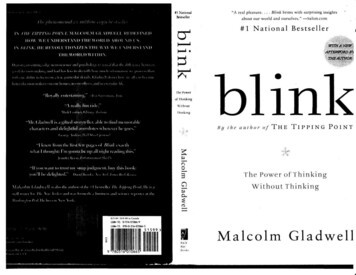
Transcription
#1 NationalBestsellercr'A real pleasure. . . . Blink brims with surprising insightsabout our world and ourselves." —Sulon.com#1 N a t i o n a l B e s t s e l l e rblinkBy 1: h e a u th o r of T H E T I P P I N G P O I N TThe Power of T h i n k i n gW i t h ou t T h i n k i n gS!fi. M / 19.(W m CanadatS8N-10: 0-316-01064-9ISBN-13: 978-0-316-01066-5!RI!llllllll!!l!lllil!l!ll!l 5 1 5 9 9Malcolm Gladwell
THE WARREN HARDINGERROR73THREEThe Warren Harding Error:Why We Fall For Tall,Dark, and Handsome MenEarly one morning in 1899, in the back garden of theGlobe Hotel in Richwood, Ohio, two men met while having their shoes shined. One was a lawyer and lobbyistfrom the state capital of Columbus. His name was HarryDaugherty. He was a thick-set, red-faced man with straightblack hair, and he was brilliant. He was the Machiavelli ofOhio politics, the classic behind-the-scenes fixer, a shrewdand insightful judge of character or, at least, political opportunity. The second man was a newspaper editor fromthe small town of Marion, Ohio, who was at that momenta week away from winning election to the Ohio state senate. His name was Warren Harding. Daugherty looked overat Harding and was instantly overwhelmed by what hesaw. As the journalist Mark Sullivan wrote, of that moment in the garden:Harding was worth looking at. He was at the time about35 years old. His head, features, shoulders and torso hada size that attracted attention; their proportions to eachother made an effect which in any male at any placewould justify more than the term handsome — in lateryears, when he came to be known beyond his localworld, the word "Roman" was occasionally used in descriptions of him. As he stepped down from the stand,his legs bore out the striking and agreeable proportionsof his body; and his lightness on his feet, his erectness, hiseasy bearing, added to the impression of physical graceand virility. His suppleness, combined with his bigness offrame, and his large, wide-set rather glowing eyes, heavyblack hair, and markedly bronze complexion gave himsome of the handsomeness of an Indian. His courtesy ashe surrendered his seat to the other customer suggestedgenuine friendliness toward all mankind. His voice wasnoticeably resonant, masculine, warm. His pleasure inthe attentions of the bootblack's whisk reflected a consciousness about clothes unusual in a small-town man.His manner as he bestowed a tip suggested generousgood-nature, a wish to give pleasure, based on physicalwell-being and sincere kindliness of heart.In that instant, as Daugherty sized up Harding, an ideacame to him that would alter American history: Wouldn'tthat man make a great President?Warren Harding was not a particularly intelligent man.He liked to play poker and golf and to drink and, most ofall, to chase women; in fact, his sexual appetites were thestuff of legend. As he rose from one political office to another, he never once distinguished himself. He was vagueand ambivalent on matters of policy. His speeches wereonce described as "an army of pompous phrases moving
74BLINKover the landscape in search of an idea." After beingelected to the U.S. Senate in 1914, he was absent for the debates on women's suffrage and Prohibition — two of thebiggest political issues of his time. He advanced steadilyfrom local Ohio politics only because he was pushed byhis wife, Florence, and stage-managed by the schemingHarry Daughcrty and because, as he grew older, he grewmore and more irresistibly distinguished-looking. Once,at a banquet, a supporter cried out, "Why, the son of a bitchlooks like a senator," and so he did. By early middle age,Harding's biographer Francis Russell writes, his "lustyblack eyebrows contrasted with his steel-gray hair to givethe effect of force, his massive shoulders and bronzed complexion gave the effect of health." Harding, according toRussell, could have put on a toga and stepped onstage in aproduction of Julius Caesar, Daugherty arranged for Harding to address the 1916 Republican presidential convention because he knew that people only had to see Hardingand hear that magnificent rumbling voice to be convincedof his worthiness for higher office. In 1920, Daughertyconvinced Harding, against Harding's better judgment, torun for the White House. Daugherty wasn't being facetious. He was serious."Daugherty, ever since the two had met, had carriedin the back of his mind the idea that Harding would makea 'great President,*" Sullivan writes. "Sometimes, unconsciously, Daugherty expressed it, with more fidelity toexactness, 'a great-looking President.'" Harding enteredthe Republican convention that summer sixth among afield of six. Daugherty was unconcerned. The conventionwas deadlocked between the two leading candidates, so,THE VARREN HARDING ERROR75Daugherty predicted, the delegates would be forced tolook for an alternative. To whom else would they turn, inthat desperate moment, if not to the man who radiatedcommon sense and dignity and all that was presidential?In the early morning hours, as they gathered in the smokefilled back rooms of the Blackstone Hotel in Chicago, theRepublican Party bosses threw up their hands and asked,wasn't there a candidate they could all agree on? And onename came immediately to mind: Harding! Didn't he lookjust like a presidential candidate? So Senator Harding became candidate Harding, and later that fall, after a campaign conducted from his front porch in Marion, Ohio,candidate Harding became President Harding. Hardingserved two years before dying unexpectedly of a stroke.He was, most historians agree, one of the worst presidentsin American history./. The Dark Side of Thin-SlicingSo far in Blink, I have talked about how extraordinarilypowerful thin-slicing can be, and what makes thin-slicingpossible is our ability to very quickly get below the surface of a situation. Thomas Hoving and Evelyn Harrisonand the an experts were instantly able to see behind theforger's artifice. Susan and Bill seemed, at first, to be theembodiment of a happy, loving couple. But when we listened closely to their interaction and measured the ratioof positive to negative emotions, we got a different story.Nalini Ambady's research showed how much we can learnabout a surgeon's likelihood of being sued if we get beyond the diplomas on the wall and the white coat and
1BLINKfocus on his or her tone of voice. But what happens if thatrapid chain of thinking gets interrupted somehow? Whatif we reach a snap judgment without ever getting belowthe surf ace?In the previous chapter, I wrote about the experimentsconducted by John Bargh in which he showed that wehave such powerful associations with certain words (forexample, "Florida," "gray," "wrinkles," and "bingo") thatjust being exposed to them can cause a change in our behavior. I think that there are facts about people's appearance — their size or shape or color or sex — that can triggera very similar set of powerful associations. Many peoplewho looked at Warren Harding saw how extraordinarilyhandsome and distinguished-looking he was and jumpedto the immediate — and entirely unwarranted — conclusion that he was a man of courage and intelligence andintegrity. They didn't dig below the surface. The way helooked carried so many powerful connotations that itstopped the normal process of thinking dead in its tracks.The Warren Harding error is the dark side of rapidcognition. It is at the root of a good deal of prejudice anddiscrimination. It's why picking the right candidate for ajob is so difficult and why, on more occasions than we maycare to admit, utter mediocrities sometimes end up in positions of enormous responsibility. Part of what it means totake thin-slicing and first impressions seriously is accepting the fact that sometimes we can know more aboutsomeone or something in the blink of an eye than we canafter months of study. But we also have to acknowledgeand understand those circumstances when rapid cognitionleads us astray.THE WARRENHARDING ERROR772. Blink in Black and WhiteOver the past few years, a number of psychologists havebegun to look more closely at the role these kinds of unconscious — or, as they like to call them, implicit — associations play in our beliefs and behavior, and much of theirwork has focused on a very fascinating tool called the Implicit Association Test (IAT). The IAT was devised by Anthony G. Greenwald, Mahzarin Banaji, and Brian Nosek,and it is based on a seemingly obvious — but nonethelessquite profound — observation. We make connections muchmore quickly between pairs of ideas that are already related in our minds than we do between pairs of ideas thatare unfamiliar to us. What does that mean? Let me giveyou an example. Below is a list of words. Take a pencil orpen and assign each name to the category to which it belongs by putting a check mark either to the left or to theright of the word. You can also do it by tapping your finger in the appropriate column. Do it as quickly as you can.Don't skip over words. And don't worry if you make gy
» I. I N KT H K W A R K F. N H A R D 1 N G E R R O RJasonLisa.MattSarah,That was easy, right? And the reason that was easy isthat when we read or hear the name "John" or "Bob" or"Holly," we don't even have to think about whether it's amasculine or a feminine name. We all have a strong priorassociation between a first name like John and the malegender, or a name like Lisa and things female.That was a warm-up. Now let's complete an actualIAT. It works like the warm-up, except that now I'mgoing to mix two entirely separate categories together.Once again, put a check mark to either the right or the leftof each word, in the category to which it belongs.MaleorCareerFemaleorFamily, .Matt. . John.Bob. .Holly.Joan79.Home.Corporation.Siblings .,.,,.,My guess is that most of you found that a little harder,but that you were still pretty fast at putting the words intothe right categories. Now try preneur.Office Joan
Lisa.Corporation.Matt.,,,,,.Did you notice the difference? This test was quite a bitharder than the one before it, wasn't it? If you are likemost people, it took you a little longer to put the word"Entrepreneur" into the "Career" category when "Career" was paired with "Female" than when "Career" waspaired with "Male." That's because most of us have muchstronger mental associations between maleness and careeroriented concepts than we do between femaleness andideas related to careers. "Male" and "Capitalist" go together in our minds a lot like "John" and "Male" did. Butwhen the category is "Male or Family," we have to stopand think — even if it's only for a few hundred milliseconds — before we decide what to do with a word like"Merchant."When psychologists administer the IAT, they usuallydon't use paper and pencil tests like the ones I've just givenyou. Most of the time, they do it on a computer. Thewords are flashed on the screen one at a time, and if a givenword belongs in the left-hand column, you hit the letter e,and if the word belongs in the right-hand column, you hitthe letter i. The advantage of doing the IAT on a computeris that the responses are measurable down to the milli-THE WARREN HARDING ERROR8lsecond, and those measurements are used in assigning thetest taker's score. So, for example, if it took you a little bitlonger to complete part two of the Work/Family IAT thanit did part one, we would say that you have a moderate association between men and the workforce. If it took you alot longer to complete part two, we'd say that when itcomes to the workforce, you have a strong automatic maleassociation.One of the reasons that the IAT has become so popular in recent years as a research tool is that the effects it ismeasuring are not subtle; as those of you who felt yourselfslowing down on the second half of the Work/Family IATabove can attest, the IAT is the kind of tool that hits youover the head with its conclusions. "When there's a strongprior association, people answer in between four hundredand six hundred milliseconds," says Greenwald. "Whenthere isn't, they might take two hundred to three hundredmilliseconds longer than that — which in the realm ofthese kinds of effects is huge. One of my cognitive psychologist colleagues described this as an effect you canmeasure with a sundial."If you'd like to try a computerized IAT, you can go towww.implicit.harvard.edu. There you'll find several tests,including the most famous of all the lATs, the Race IAT.I've taken the Race IAT on many occasions, and the resultalways leaves me feeling a bit creepy. At the beginning ofthe test, you are asked what your attitudes toward blacksand whites are. I answered, as I am sure most of you would,that I think of the races as equal. Then comes the test.You're encouraged to complete it quickly. First comes thewarm-up. A series of pictures of faces flash on the screen.
THE W A R R E NBLINKWhen you see a black face, you press e and put it in theleft-hand category. When you see a white face, you pressi and put it in the right-hand category. It's blink, blink,blink: I didn't have to think at all. Then comes part one.European AmericanorBadAfrican AmericanorGoodHARDINGthing to one category when I really meant to assign it tothe other category. I was trying as hard as I could, and inthe back of my mind was a growing sense of mortification.Why was I having such trouble when I had to put a wordlike "Glorious" or "Wonderful" into the "Good" categorywhen "Good" was paired with "African American" orwhen I had to put the word "Evil" into the "Bad" categorywhen "Bad" was paired with "European American"? Thencame part two. This time the categories were reversed.European AmericanorGood.WonderfulAnd so on. Immediately, something strange happened tome. The task of putting the words and faces in the rightcategories suddenly became more difficult. I found myselfslowing down. 1 had to think. Sometimes I assigned some-ERROR.WonderfulAfrican AmericanorBad
84BLINKAnd so on. Now my mortification grew still further. NowI was having no trouble at all.Evil? African American or Bad.Hurt? African American or Bad.Wonderful? European American or Good.I took the test a second time, and then a third time, andthen a fourth time, hoping that the awful feeling of biaswould go away. It made no difference. It turns out thatmore than So percent of all those who have ever taken thetest end up having pro-white associations, meaning that ittakes them measurably longer to complete answers whenthey are required to put good words into the "Black" category than when they arc required to link bad things withblack people. I didn't do quite so badly. On the Race IAT,I was rated as having a "moderate automatic preference forwhites." But then again, I'm half black. (My mother isJamaican.)So what docs this mean? Does this mean I'm a racist, aself-hating black person? Not exactly. What it means isthat our attitudes toward things like race or gender operate on two levels. First of all, we have our conscious attitudes. This is what we choose to believe. These are ourstated values, which we use to direct our behavior deliberately. The apartheid policies of South Africa or the laws inthe American South that made it difficult for AfricanAmericans to vote are manifestations of conscious discrimination, and when we talk about racism or the fightfor civil rights, this is the kind of discrimination that weusually refer to. But the IAT measures something else. Itmeasures our second level of attitude, our racial attitudeon an unconscious level — the immediate, automatic asso-THE WARREN HARDINGERRORciations that tumble out before we've even had time tothink. We don't deliberately choose our unconscious attitudes. And as I wrote about in the first chapter, we maynot even be aware of them. The giant computer that is ourunconscious silently crunches all the data it can from theexperiences we've had, the people we've met, the lessonswe've learned, the books we've read, the movies we'veseen, and so on, and it forms an opinion. That's what iscoming out in the IAT.The disturbing thing about the test is that it shows thatour unconscious attitudes may be utterly incompatiblewith our stated conscious values. As it turns out, for example, of the fifty thousand African Americans who havetaken the Race IAT so far, about half of them, like me,have stronger associations with whites than with blacks.How could we not? We live in North America, where weare surrounded every day by cultural messages linkingwhite with good. "You don't choose to make positive associations with the dominant group," says Mahzarin Banaji, who teaches psychology at Harvard University and isone of the leaders in IAT research. "But you are requiredto. All around you, that group is being paired with goodthings. You open the newspaper and you turn on the television, and you can't escape it."The IAT is more than just an abstract measure of attitudes. It's also a powerful predictor of how we act incertain kinds of spontaneous, situations. If you have astrongly pro-white pattern of associations, for example,there is evidence that that will affect the way you behave inthe presence of a black person. It's not going to affect whatyou'll choose to say or feel or do. In all likelihood, you
BLINKwon't be aware that you're behaving any differently thanyou would around a white person. But chances are you'lllean forward a little less, turn away slightly from him orher, close your body a bit, be a bit less expressive, maintainless eye contact, stand a little farther away, smile a lot less,hesitate and stumble over your words a bit more, laugh atjokes a bit less. Does that matter? Of course it does. Suppose the conversation is a job interview. And suppose theapplicant is a black man. He's going to pick up on that uncertainty and distance, and that may well make him a littleless certain of himself, a little less confident, and a little lessfriendly. And what will you think then? You may well geta gut feeling that the applicant doesn't really have what ittakes, or maybe that he is a bit standoffish, or maybe thathe doesn't really want the job. What this unconscious firstimpression will do, in other words, is throw the interviewhopelessly off course.Or what if the person you are interviewing is tall? I'msure that on a conscious level we don't think that we treattall people any differently from how we treat short people.But there's plenty of evidence to suggest that height —particularly in men — does trigger a certain set of very positive unconscious associations. I polled about half of thecompanies on the Fortune 500 list — the list of the largestcorporations in the United States — asking each companyquestions about its CEO. Overwhelmingly, the heads ofbig companies are, as I'm sure comes as no surprise to anyone, white men, which undoubtedly reflects some kind ofimplicit bias. But they are also almost all tall: in my sample,I found that on average, male CEOs were just a shadeunder six feet tall. Given that the average American male isTHE WARREN HARDING ERRORfive foot nine, that means that CEOs as a group have aboutthree inches on the rest of their sex. But this statistic actually understates the matter. In the U.S. population, about14.5 percent of all men are six feet or taller. Among CEOsof Fortune 500 companies, that number is 58 percent. Evenmore striking, in the general American population, 3.9 percent of adult men are six foot two or taller. Among myCEO sample, almost a third were six foot two or taller.The lack of women or minorities among the top executive ranks at least has a plausible explanation. For years,for a number of reasons having to do with discriminationand cultural patterns, there simply weren't a lot of womenand minorities entering the management ranks of American corporations. So, today, when boards of directors lookfor people with the necessary experience to be candidatesfor top positions, they can argue somewhat plausibly thatthere aren't a lot of women and minorities in the executivepipeline. But this is not true of short people. It is possibleto staff a large company entirely with white males, but it isnot possible to staff a large company without short people.There simply aren't enough tall people to go around. Yetfew of those short people ever make it into the executivesuite. Of the tens of millions of American men below fivefoot six, a grand total of ten in my sample have reached thelevel of CEO, which says that being short is probably asmuch of a handicap to corporate success as being a womanor an African American. (The grand exception to all ofthese trends is American Express CEO Kenneth Chenault,who is both on the short side —five foot nine—and black.He must be a remarkable man to have overcome two Warren Harding errors.)
88II. I N KIs this a deliberate prejudice? Of course not. No oneever says dismissively of a potential CEO candidate thathe's too short. This is quite clearly the kind of unconsciousbias that the IAT picks up on. Most of us, in ways that weare not entirely aware of, automatically associate leadershipability with imposing physical stature. We have a sense ofwhat a leader is supposed to look like, and that stereotype isso powerful that when someone fits it, we simply becomeblind to other considerations. And this isn't confined to theexecutive suite. Not long ago, researchers who analyzed thedata from four large research studies that had followedthousands of people from birth to adulthood calculated thatwhen corrected tor such variables as age and gender andweight, an inch of height is worth 789 a year in salary. Thatmeans that a person who is six feet tall but otherwise identical to someone who is five foot five will make on average 5,525 more per year. As Timothy Judge, one of the authorsof the height-salary study, points out: "If you take this overthe course of a 30-year career and compound it, we're talking about a tall person enjoying literally hundreds of thousands of dollars of earnings advantage." Have you everwondered why so many mediocre people find their wayinto positions of authority in companies and organizations?It's because when it comes to even the most important positions, our selection decisions are a good deal less rationalthan we think. We sec a tall person and we swoon.j. Taking Care of the CustomerThe sales director of the Flemington Nissan dealership inthe central New Jersey town of Flemington is a manTHE WARREN H A R D I N G E R R O R89named Bob Golomb. Golomb is in his fifties, with short,thinning black hair and wire-rimmed glasses. He wearsdark, conservative suits, so that he looks like a bank manager or a stockbroker. Since starting in the car businessmore than a decade ago, Golomb has sold, on average,about twenty cars a month, which is more than doublewhat the average car salesman sells. On his desk Golombhas a row of five gold stars, given to him by his dealershipin honor of his performance. In the world of car salesmen,Golomb is a virtuoso.Being a successful salesman like Golomb is a task thatplaces extraordinary demands on the ability to thin-slice.Someone you've never met walks into your dealership,perhaps about to make what may be one of the most expensive purchases of his or her life. Some people are insecure. Some are nervous. Some know exactly what theywant. Some have no idea. Some know a great deal aboutcars and will be offended by a salesman who adopts a patronizing tone. Some are desperate for someone to takethem by the hand and make sense of what seems to themlike an overwhelming process. A salesman, if he or she isto be successful, has to gather all of that information—figuring out, say, the dynamic that exists between a husbandand a wife, or a father and a daughter — process it, and adjust his or her own behavior accordingly, and do all of thatwithin the first few moments of the encounter.Bob Golomb is clearly the kind of person who seems todo that kind of thin-slicing effortlessly. He's the EvelynHarrison of car selling. He has a quiet, watchful intelligenceand a courtly charm. He is thoughtful and attentive. He's awonderful listener. He has, he says, three simple rules that
BLINKguide his every action: "Take care of the customer. Take careof the customer. Take care of the customer." If you buy a carfrom Bob Golomb, he will be on the phone to you the nextday, making sure everything is all right. If you come to thedealership but don't end up buying anything, he'll call youthe next day, thanking you for stopping by. "You alwaysput on your best face, even if you are having a bad day. Youleave that behind," he says. "Even if things are horrendousat home, you give the customer your best."When 1 met Golomb, he took out a thick three-ringbinder rilled with the mountain of letters he had receivedover the years from satisfied customers. "Each one ofthese has a story to tell," he said. He seemed to rememberevery one. As he flipped through the book, he pointedrandomly at a short typewritten letter. "Saturday afternoon, late November 1992. A couple. They came in withthis glazed look on their faces. I said, 'Folks, have youbeen shopping for cars all day?' They said yes. No one hadtaken them seriously. I ended up selling them a car, and wehad to get it from, I want to say, Rhode Island. We sent adriver four hundred miles. They were so happy." Hepointed at another letter. "This gentleman here. We've delivered six cars to him already since 1993, and every timewe deliver another car, he writes another letter. There's alot like that. Here's a guy who lives way down by Keyport, New Jersey, forty miles away. He brought me up aplatter of scallops."There is another even more important reason forGolomb's success, however. He follows, he says, anothervery simple rule. He may make a million snap judgmentsabout a customer's needs and state of mind, but he triesTHE WARREN HARDING ERRORnever to judge anyone on the basis of his or her appearance. He assumes that everyone who walks in the door hasthe exact same chance of buying a car."You cannot prejudge people in this business," he saidover and over when we met, and each time he used thatphrase, his face took on a look of utter conviction. "Prejudging is the kiss of death. You have to give everyoneyour best shot. A green salesperson looks at a customerand says, 'This person looks like he can't afford a car,'which is the worst thing you can do, because sometimesthe most unlikely person is flush," Golomb says. "I have afarmer I deal with, who I've sold all kinds of cars over theyears. We seal our deal with a handshake, and he hands mea hundred-dollar bill and says, 'Bring it out to my farm.'We don't even have to write the order up. Now, if you sawthis man, with his coveralls and his cow dung, you'd figurehe was not a worthy customer. But in fact, as we say inthe trade, he's all cashed up. Or sometimes people see ateenager and they blow him off. Well, then later that night,the teenager comes back with Mom and Dad, and theypick up a car, and it's the other salesperson that writesthem up."What Golomb is saying is that most salespeople areprone to a classic Warren Harding error. They see someone, and somehow they let the first impression they haveabout that person's appearance drown out every otherpiece of information they manage to gather in that first instant. Golomb, by contrast, tries to be more selective. Hehas his antennae out to pick up on whether someone isconfident or insecure, knowledgeable or naive, trusting orsuspicious — but from that thin-slicing flurry he tries to
BLINKedit out those impressions based solely on physical appearance. The secret of Golomb's success is that he has decided to fight the Warren Harding error.4. Spotting the SuckerWhy does Bob Golomb's strategy work so well? BecauseWarren Harding errors, it turns out, play an enormous,largely unacknowledged role in the car-selling business.Consider, for example, a remarkable social experimentconducted in the 19905 by a law professor in Chicagonamed Ian Ayres. Ayres put together a team of thirtyeight people — eighteen white men, seven white women,eight black women, and five black men. Ayres took greatpains to make them appear as similar as possible. All werein their mid-twenties. All were of average attractiveness.All were instructed to dress in conservative casual wear:the women in blouses, straight skirts, and flat shoes; themen in polo shirts or button-downs, slacks, and loafers.All were given the same cover story. They were instructedto go to a total of 242 car dealerships in the Chicago areaand present themselves as college-educated young professionals (sample job: systems analyst at a bank) living inthe tony Chicago neighborhood of Streetcrville. Their instructions for what to do were even more specific. Theyshould walk in. They should wait to be approached by asalesperson. "I'm interested in buying this car," they weresupposed to say, pointing to the lowest-priced car in theshowroom. Then, after they heard the salesman's initialoffer, they were instructed to bargain back and forth untilthe salesman either accepted an offer or refused to bargainTHE WARRENHARDINGERROR93any further — a process that in almost all cases took aboutforty minutes. What Ayres was trying to do was zero in ona very specific question: All other things being absolutelyequal, how does skin color or gender affect the price that asalesman in a car dealership offers?The results were stunning. The white men receivedinitial offers from the salesmen that were 725 above thedealer's invoice (that is, what the dealer paid for the carfrom the manufacturer). White women got initial of
someone or something in the blink of an eye than we can after months of study. But we also have to acknowledge and understand those circumstances when rapid cognition leads us astray. THE WARREN HARDING ERROR 77 2. Blink in Black and White Over the past few years, a number of psychologists ha
